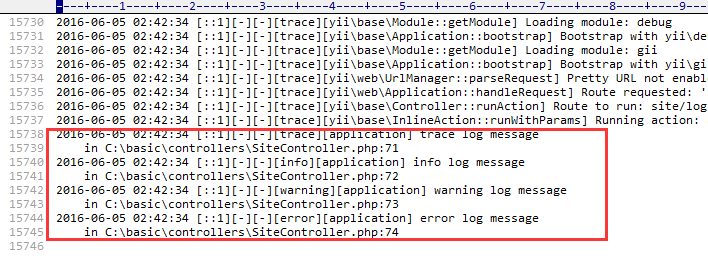Yii紀錄檔記錄
Yii提供一個高度可客製化,可延伸的框架。
有了這個框架的幫助,就可以輕鬆地記錄各種型別的訊息。
要紀錄檔記錄資訊/訊息,應該呼叫下面的方法 -
-
Yii::error() ? 記錄一個致命錯誤訊息
-
Yii::warning() ? 記錄一個警告訊息
-
Yii::info() ? 記錄一些有用資訊的訊息
-
Yii::trace() ? 記錄訊息跟蹤一段程式碼如何執行
在上述不同類別方法記錄紀錄檔資訊。都具有以下函式簽名 -
function ($message, $category = 'application')
在這裡 ?
-
$message ? 要記錄的紀錄檔訊息
-
$category ? 紀錄檔訊息類別
簡單和方便的命名方式是使用 PHP 的 __METHOD__ 魔術常數。例如 -
Yii::info('this is a log message', __METHOD__);
紀錄檔目標是 yii\log\Target class 類的一個範例。它通過類別過濾所有紀錄檔資訊並匯出檔案、資料庫和/或電子郵件。
第1步 - 也可以註冊多個紀錄檔目標,如下:
return [
// the "log" component is loaded during bootstrapping time
'bootstrap' => ['log'],
'components' => [
'log' => [
'targets' => [
[
'class' => 'yii\log\DbTarget',
'levels' => ['error', 'warning', 'trace', 'info'],
],
[
'class' => 'yii\log\EmailTarget',
'levels' => ['error', 'warning'],
'categories' => ['yii\db\*'],
'message' => [
'from' => ['[email protected]'],
'to' => ['[email protected]', '[email protected]'],
'subject' => 'Application errors at mydomain.com',
],
],
],
],
],
];
在上面的程式碼,有兩個目標被註冊。第一個目標選擇了所有的錯誤,警告,跟蹤和資訊訊息,並在資料庫中儲存它們。第二個目標將傳送所有錯誤和警告訊息到管理員的電子郵件。
Yii提供以下內建紀錄檔的目標 -
-
yii\log\DbTarget ? 在資料庫中儲存紀錄檔訊息
-
yii\log\FileTarget ? 在檔案中儲存記錄訊息
-
yii\log\EmailTarget ? 傳送長訊息到預先定義的電子郵件地址
-
yii\log\SyslogTarget ? 通過呼叫 PHP syslog()函式將紀錄檔資訊儲存到系統紀錄檔
預設情況下,紀錄檔訊息的格式如下 -
Timestamp [IP address][User ID][Session ID][Severity Level][Category] Message Text
第2步 - 要自定義格式則組態 yii\log\Target::$prefix 屬性。 例如。
[
'class' => 'yii\log\FileTarget',
'prefix' => function ($message) {
$user = Yii::$app->has('user', true) ? Yii::$app->get('user') :
'undefined user';
$userID = $user ? $user->getId(false) : 'anonym';
return "[$userID]";
}
]
上面的程式碼片段組態紀錄檔目標,使用當前使用者ID為字首的紀錄檔訊息。
預設情況下,紀錄檔訊息包含這些全域性PHP變數的值:$_GET,$_POST,$_SESSION,$_COOKIE,$_FILES 和 $_SERVER。
若要修改此行為,則可以組態 yii\log\Target::$logVars 組態,需要包括變數名。
所有紀錄檔資訊都儲存在由記錄物件的陣列。 Logger物件每次重新整理記錄的訊息到紀錄檔目標,陣列積累了一定數量訊息(預設為1000)。
第3步 - 要自定義這個數位,則可以呼叫 flushInterval 屬性。
return [
'bootstrap' => ['log'],
'components' => [
'log' => [
'flushInterval' => 50, // default is 1000
'targets' => [...],
],
],
];
即使在Logger物件重新整理紀錄檔資訊記錄的目標,它們也不會立即匯出。當紀錄檔目標積累了一定數量的訊息(預設為1000)時就會匯出。
第4步 - 要自定義這個數位,可以組態 exportInterval 屬性的值。
[ 'class' => 'yii\log\FileTarget', 'exportInterval' => 50, // default is 1000 ]
第5步 - 現在,修改 config/web.php 檔案,如下所示程式碼。
<?php
$params = require(__DIR__ . '/params.php');
$config = [
'id' => 'basic',
'basePath' => dirname(__DIR__),
'bootstrap' => ['log'],
'components' => [
'request' => [
// !!! insert a secret key in the following (if it is empty) - this
//is required by cookie validation
'cookieValidationKey' => 'ymoaYrebZHa8gURuolioHGlK8fLXCKjO',
],
'cache' => [
'class' => 'yii\caching\FileCache',
],
'user' => [
'identityClass' => 'app\models\User',
'enableAutoLogin' => true,
],
'errorHandler' => [
'errorAction' => 'site/error',
],
'mailer' => [
'class' => 'yii\swiftmailer\Mailer',
// send all mails to a file by default. You have to set
// 'useFileTransport' to false and configure a transport
// for the mailer to send real emails.
'useFileTransport' => true,
],
'log' => [
'flushInterval' => 1,
'traceLevel' => YII_DEBUG ? 3 : 0,
'targets' => [
[
'class' => 'yii\log\FileTarget',
'exportInterval' => 1,
'logVars' => []
],
],
],
'db' => require(__DIR__ . '/db.php'),
],
'modules' => [
'admin' => [
'class' => 'app\modules\admin\Admin',
],
],
'params' => $params,
];
if (YII_ENV_DEV) {
// configuration adjustments for 'dev' environment
$config['bootstrap'][] = 'debug';
$config['modules']['debug'] = [
'class' => 'yii\debug\Module',
];
$config['bootstrap'][] = 'gii';
$config['modules']['gii'] = [
'class' => 'yii\gii\Module',
];
}
return $config;
?>
在上面的程式碼中,我們定義紀錄檔應用程式元件,並設定 flushInterval 和 exportInteval 屬性的值為 1 ,以便所有紀錄檔訊息立即匯出在紀錄檔檔案中。
這裡還忽略了紀錄檔目標級別(levels )屬性。這意味著,所有類別的紀錄檔訊息(錯誤,警告,資訊,跟蹤)將會記錄在紀錄檔檔案中。
第6步 - 然後,在 SiteController 中呼叫 actionLog() 函式。
public function actionLog() {
Yii::trace('trace log message');
Yii::info('info log message');
Yii::warning('warning log message');
Yii::error('error log message');
}
在上面的程式碼中,只寫4個不同型別的紀錄檔訊息到紀錄檔檔案。
第7步 - 在Web瀏覽器的位址列開啟 URL http://localhost:8080/index.php?r=site/log
紀錄檔訊息出現在 app/runtime/logs 目錄下的 app.log 檔案中。

